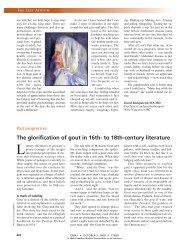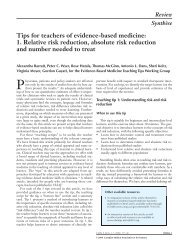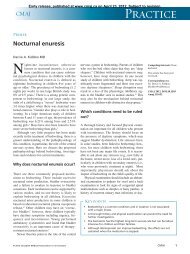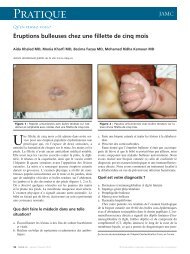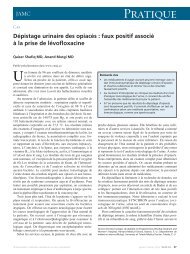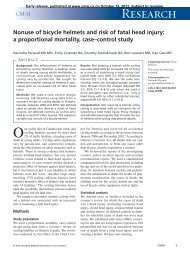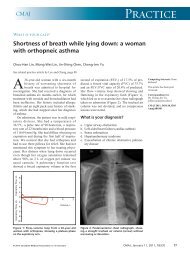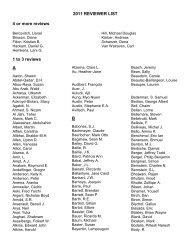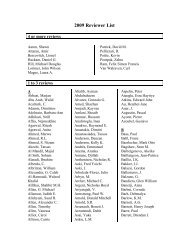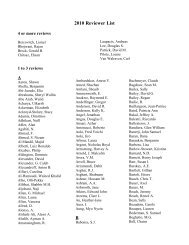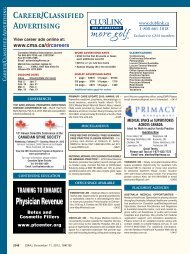Playing-related musculoskeletal disorders in musicians - Canadian ...
Playing-related musculoskeletal disorders in musicians - Canadian ...
Playing-related musculoskeletal disorders in musicians - Canadian ...
Create successful ePaper yourself
Turn your PDF publications into a flip-book with our unique Google optimized e-Paper software.
<strong>Play<strong>in</strong>g</strong>-<strong>related</strong> <strong>musculoskeletal</strong><br />
<strong>disorders</strong> <strong>in</strong> <strong>musicians</strong>: a systematic<br />
review of <strong>in</strong>cidence and prevalence<br />
Christ<strong>in</strong>e Zaza, PhD<br />
Abstract<br />
Background: Work-<strong>related</strong> <strong>musculoskeletal</strong> <strong>disorders</strong> cause pa<strong>in</strong>, disability and<br />
loss of employment for many workers, <strong>in</strong>clud<strong>in</strong>g <strong>musicians</strong>. Although perform<strong>in</strong>g<br />
arts medic<strong>in</strong>e is a grow<strong>in</strong>g field, the health problems of <strong>musicians</strong> rema<strong>in</strong><br />
under-recognized and under-researched. Therefore, the author undertook a systematic<br />
review of published <strong>in</strong>formation on the <strong>in</strong>cidence and prevalence of<br />
play<strong>in</strong>g-<strong>related</strong> <strong>musculoskeletal</strong> <strong>disorders</strong> (PRMDs) <strong>in</strong> classical <strong>musicians</strong>.<br />
Methods: Seven databases were searched for the period 1980 to 1996. The ma<strong>in</strong><br />
textbook and perform<strong>in</strong>g arts medic<strong>in</strong>e journals were searched manually, as<br />
were reference lists of all relevant papers. The author also contacted <strong>in</strong>dividuals<br />
familiar with the literature of perform<strong>in</strong>g arts medic<strong>in</strong>e. Studies were <strong>in</strong>cluded<br />
for review if they reported PRMD <strong>in</strong>cidence or prevalence <strong>in</strong> classical <strong>musicians</strong>.<br />
Of the 24 studies identified, 18 cross-sectional surveys and cohort studies<br />
were reviewed. The author subjectively assessed the studies us<strong>in</strong>g criteria modified<br />
from an exist<strong>in</strong>g evaluation scale and used 4 criteria for data comb<strong>in</strong>ation.<br />
On the basis of prevalence values from the eligible studies, χ 2 tests for heterogeneity<br />
were performed.<br />
Results: Only one study estimated PRMD <strong>in</strong>cidence. Ten of the 17 prevalence<br />
studies were <strong>in</strong>eligible for data comb<strong>in</strong>ation, because of low response rates and<br />
other methodological problems. In the 7 eligible studies, PRMD po<strong>in</strong>t prevalence<br />
ranged from 39% to 87% <strong>in</strong> adult <strong>musicians</strong> and from 34% to 62% <strong>in</strong><br />
secondary school music students. The best estimates of PRMD prevalence were<br />
derived from the 3 studies that excluded mild compla<strong>in</strong>ts; these studies <strong>in</strong>dicated<br />
that PRMD prevalence was 39% and 47% <strong>in</strong> adults and 17% <strong>in</strong> secondary<br />
school music students respectively. Statistical comb<strong>in</strong>ation of data across<br />
studies with<strong>in</strong> each demographic category was not possible.<br />
Interpretation: Available data <strong>in</strong>dicate that the prevalence of PRMD <strong>in</strong> adult classical<br />
<strong>musicians</strong> is comparable to the prevalence of work-<strong>related</strong> <strong>musculoskeletal</strong><br />
<strong>disorders</strong> reported for other occupational groups. Several recommendations for<br />
future research are outl<strong>in</strong>ed.<br />
Résumé<br />
Contexte : Les troubles musculosquelettiques liés au travail sont une cause de<br />
douleur, d’<strong>in</strong>capacité et de perte d’emploi pour beaucoup de travailleurs, y<br />
compris les musiciens. Même si la médec<strong>in</strong>e des arts du spectacle est un doma<strong>in</strong>e<br />
en ple<strong>in</strong>e croissance, les problèmes de santé des musiciens ne sont pas<br />
suffisamment reconnus et les recherches en la matière sont <strong>in</strong>suffisantes. L’auteur<br />
a donc entrepris une recension systématique des documents publiés sur<br />
l’<strong>in</strong>cidence et la prévalence de troubles musculosquelettiques liés à l’exécution<br />
de la musique (TMEM) chez les musiciens classiques.<br />
Méthodes : On a effectué, dans sept bases de données, une recherche portant sur<br />
la période de 1980 à 1996. L’auteur a effectué une recherche manuelle dans le<br />
pr<strong>in</strong>cipal manuel, dans des journaux sur la médec<strong>in</strong>e des arts du spectacle, a<strong>in</strong>si<br />
que dans les listes de références de tous les documents pert<strong>in</strong>ents. Elle a aussi<br />
communiqué avec des personnes qui connaissent bien les publications sur la<br />
médec<strong>in</strong>e des arts du spectacle. L’auteur a <strong>in</strong>clus les études qui faisaient état<br />
Evidence<br />
Études<br />
Dr. Zaza is a National Cancer<br />
Institute of Canada Research<br />
Fellow at the Department<br />
of Oncology, University<br />
of Western Ontario, London,<br />
Ont.<br />
Presented <strong>in</strong> part at the<br />
“Health and the Musician”<br />
conference of the British<br />
Association for Perform<strong>in</strong>g<br />
Arts Medic<strong>in</strong>e, York, England,<br />
Mar. 23–27, 1997.<br />
This article has been peer reviewed.<br />
CMAJ 1998;158:1019-25<br />
CMAJ • APR. 21, 1998; 158 (8) 1019<br />
© 1998 <strong>Canadian</strong> Medical Association (text and abstract/résumé)
Zaza<br />
Work-<strong>related</strong> <strong>musculoskeletal</strong> <strong>disorders</strong> cause<br />
pa<strong>in</strong>, disability and loss of employment for<br />
workers <strong>in</strong> many occupations. 1,2 The focus has<br />
been on the back <strong>in</strong>juries and <strong>musculoskeletal</strong> <strong>disorders</strong> of<br />
workers <strong>in</strong> offices and <strong>in</strong>dustries, but evidence is <strong>in</strong>creas<strong>in</strong>g<br />
to <strong>in</strong>dicate that <strong>musicians</strong> are also vulnerable. Although<br />
perform<strong>in</strong>g arts medic<strong>in</strong>e has grown substantially<br />
s<strong>in</strong>ce 1980, the health problems of <strong>musicians</strong> rema<strong>in</strong><br />
under-recognized and under-researched. Little is known<br />
about the magnitude of the problem, the factors that<br />
place <strong>musicians</strong> at risk, the therapies that are effective and<br />
appropriate for <strong>musicians</strong> and the ways <strong>in</strong> which <strong>musicians</strong><br />
can prevent these problems.<br />
Common play<strong>in</strong>g-<strong>related</strong> <strong>musculoskeletal</strong> <strong>disorders</strong><br />
(PRMDs) of <strong>musicians</strong> <strong>in</strong>clude overuse problems, such as<br />
tendonitis, and peripheral nerve entrapment syndromes.<br />
These conditions typically affect the upper extremities, the<br />
neck, the back and the facial musculature. PRMDs experienced<br />
by <strong>musicians</strong> often become chronic, pa<strong>in</strong>ful, disabl<strong>in</strong>g<br />
health problems that last, on average, from 2 to 5<br />
years. 3–5 The economic effects of PRMDs among <strong>musicians</strong><br />
are significant, especially given that most <strong>Canadian</strong><br />
<strong>musicians</strong> are self-employed and do not qualify for workers’<br />
compensation benefits. Because <strong>musicians</strong> earn, on average,<br />
less than $20 000 per year from their musical work,<br />
many of them hold several jobs, 6 and a PRMD can affect a<br />
musician’s ability to earn a liv<strong>in</strong>g from any job, musical or<br />
otherwise. The arts and culture <strong>in</strong>dustry is mak<strong>in</strong>g an <strong>in</strong>creas<strong>in</strong>gly<br />
significant contribution to the <strong>Canadian</strong> economy.<br />
7 The total revenue from music <strong>in</strong> Canada was over<br />
1020 JAMC • 21 AVR. 1998; 158 (8)<br />
d’une <strong>in</strong>cidence ou d’une prévalence de TMEM chez des musiciens classiques.<br />
Sur les 24 études repérées, on a exam<strong>in</strong>é 18 sondages représentatifs et études<br />
de cohorte. L’auteur a évalué subjectivement les études en se fondant sur des<br />
critères tirés d’une échelle d’évaluation existante qu’elle a modifiée et elle a<br />
utilisé quatre critères pour comb<strong>in</strong>er les données. En se fondant sur les valeurs<br />
de prévalence tirées des études utilisables, elle a procédé à des tests de χ 2 pour<br />
déterm<strong>in</strong>er l’hétérogénéité.<br />
Résultats : On a estimé l’<strong>in</strong>cidence des TMEM dans une étude seulement. Des 17<br />
études de prévalence, 10 n’ont pu servir à la comb<strong>in</strong>aison des données à cause<br />
de la faiblesse des taux de réponse et d’autres problèmes de méthodologie.<br />
Dans les sept études utilisables, le moment de prévalence de TMEM a varié de<br />
39 % à 87 % chez les musiciens adultes et de 34 % à 62 % chez les étudiants<br />
en musique du niveau secondaire. La meilleure estimation de la prévalence des<br />
TMEM a été tirée des trois études qui ont exclu les pla<strong>in</strong>tes portant sur des troubles<br />
légers. Ces études ont <strong>in</strong>diqué que la prévalence des TMEM s’établissait à<br />
39 % et 47 % chez les adultes et à 17 % chez les étudiants en musique du<br />
niveau secondaire, respectivement. Il n’a pas été possible de comb<strong>in</strong>er statistiquement<br />
les données tirées d’études dans chaque catégorie démographique.<br />
Interprétation : Les données disponibles <strong>in</strong>diquent que la prévalence des TMEM<br />
chez les musiciens classiques adultes est comparable à celle des troubles musculosquelettiques<br />
liés au travail signalés dans le cas d’autres catégories professionnelles.<br />
L’auteur présente plusieurs recommandations sur des recherches futures.<br />
$111 million <strong>in</strong> 1993, 8 and <strong>in</strong> 1993–94 arts and culture directly<br />
contributed $29.2 billion (4.7%) to the gross domestic<br />
product, with almost 900 000 (6.9%) direct jobs depend<strong>in</strong>g<br />
on this <strong>in</strong>dustry. 7<br />
Nonetheless, many people do not view the arts as a<br />
legitimate profession, and the occupational health problems<br />
of <strong>musicians</strong> are seen as <strong>in</strong>trigu<strong>in</strong>g oddities rather<br />
than serious concerns. Anecdotal <strong>in</strong>formation about<br />
physicians’ responses to <strong>musicians</strong> suggests a similar<br />
view <strong>in</strong> the medical profession. 9,10 Family physicians are<br />
now more likely to encounter <strong>musicians</strong> <strong>in</strong> their practices,<br />
11 either for treatment or for referral for specialized<br />
care. Consultation with physicians and therapists at<br />
“<strong>musicians</strong>’ cl<strong>in</strong>ics” may be an option for some <strong>musicians</strong>,<br />
but there are few such cl<strong>in</strong>ics, 12 and referr<strong>in</strong>g<br />
physicians may not be aware of them.<br />
Information on the work-<strong>related</strong> <strong>musculoskeletal</strong> <strong>disorders</strong><br />
of <strong>in</strong>dustry and office workers, for example, is<br />
easily accessible to health care professionals. However,<br />
<strong>in</strong>formation on <strong>musicians</strong>’ occupational health problems<br />
is difficult to locate, even though, s<strong>in</strong>ce 1980, over 6000<br />
<strong>musicians</strong> <strong>in</strong> several countries have participated <strong>in</strong> surveys<br />
and other research studies. Of the 2 published narrative<br />
reviews of this literature, the first 13 was published<br />
before most of the prevalence studies were conducted,<br />
and the second 14 is not comprehensive. Both lack a critical<br />
evaluation of primary studies.<br />
This systematic review addresses the <strong>in</strong>cidence and<br />
prevalence of play<strong>in</strong>g-<strong>related</strong> <strong>musculoskeletal</strong> <strong>disorders</strong><br />
<strong>in</strong> classically tra<strong>in</strong>ed <strong>musicians</strong>.
Methods<br />
For this review, the term PRMD is used to refer to a<br />
host of <strong>musculoskeletal</strong> problems (e.g., carpal tunnel<br />
syndrome, epicondylitis, tendonitis and other conditions<br />
<strong>related</strong> to overuse). The use of an aggregate term is<br />
based on the hypothesis that the <strong>in</strong>dividual conditions<br />
share several common etiologic factors; 15 however, use of<br />
the aggregate term does not necessarily imply that<br />
causality has been demonstrated.<br />
Inclusion and exclusion criteria<br />
This review <strong>in</strong>cluded cross-sectional surveys and cohort<br />
studies whose primary outcome was the <strong>in</strong>cidence<br />
or prevalence of PRMDs <strong>in</strong> classically tra<strong>in</strong>ed <strong>musicians</strong>.<br />
To m<strong>in</strong>imize bias, I excluded case series, follow-up studies,<br />
studies of a specific technical aspect of play<strong>in</strong>g and<br />
studies <strong>in</strong> which most of the subjects had not been classically<br />
tra<strong>in</strong>ed.<br />
Search<strong>in</strong>g techniques<br />
The follow<strong>in</strong>g databases were searched for the period<br />
1980 to 1996: MEDLINE, the Cumulative Index to<br />
Nurs<strong>in</strong>g and Allied Health Literature (CINAHL), Sports<br />
Discus, the Social Sciences Index and PsychInfo Lit. All<br />
searches except those of MEDLINE and CINAHL were<br />
restricted to English-language articles. The search terms<br />
<strong>in</strong>cluded “music,” “musician,” “<strong>in</strong>strumentalist,” “pa<strong>in</strong>,”<br />
“disability,” “overuse,” “<strong>musculoskeletal</strong> diseases” and<br />
“<strong>musculoskeletal</strong> system.” The terms “pa<strong>in</strong>,” “<strong>musculoskeletal</strong><br />
diseases” and “<strong>musculoskeletal</strong> system” were exploded<br />
accord<strong>in</strong>g to accepted search techniques. The Occupational<br />
Diseases of Perform<strong>in</strong>g Artists Bibliography<br />
from the Library of the Medical and Chirurgical Faculty<br />
of Maryland was searched onl<strong>in</strong>e, item by item. I searched<br />
the Computer-Assisted Information Retrieval Service<br />
System for Music onl<strong>in</strong>e us<strong>in</strong>g the key words “perform<strong>in</strong>g<br />
arts medic<strong>in</strong>e,” “survey” and “prevalence.” In addition to<br />
the computerized searches, I searched the 2 ma<strong>in</strong> perform<strong>in</strong>g<br />
arts medic<strong>in</strong>e journals manually, cover<strong>in</strong>g all issues<br />
of Medical Problems of Perform<strong>in</strong>g Artists (1986 to<br />
March 1996) and the International Journal of Arts Medic<strong>in</strong>e<br />
(1991 to 1995). The ma<strong>in</strong> perform<strong>in</strong>g arts medic<strong>in</strong>e text 16<br />
and the reference lists of all relevant papers were also<br />
searched manually. F<strong>in</strong>ally, I identified a study that was <strong>in</strong><br />
press at the time of search<strong>in</strong>g, and I contacted <strong>in</strong>dividuals<br />
familiar with the perform<strong>in</strong>g arts medic<strong>in</strong>e literature.<br />
Assessment of study quality<br />
Studies were eligible for <strong>in</strong>clusion if they met the fol-<br />
low<strong>in</strong>g criteria: the study was subjectively classified as at<br />
least moderate accord<strong>in</strong>g to criteria modified from an<br />
exist<strong>in</strong>g evaluation scale, 17 the response rate was greater<br />
than 60%, the orig<strong>in</strong>al data were provided (or it was<br />
possible to calculate prevalence), po<strong>in</strong>t prevalence was<br />
provided and the data had been collected by an unbl<strong>in</strong>ded<br />
<strong>in</strong>vestigator us<strong>in</strong>g systematic methods. Studies<br />
that met these evaluation criteria and that differentiated<br />
between mild, moderate and severe symptoms provided<br />
the best estimates of PRMD prevalence.<br />
Data extraction<br />
I obta<strong>in</strong>ed hard copies of all eligible studies and extracted<br />
the follow<strong>in</strong>g <strong>in</strong>formation: authors’ names, publication<br />
year, source, country, study design, sample size,<br />
response rate, description of subjects and ma<strong>in</strong> outcome<br />
(<strong>in</strong>cidence or prevalence).<br />
Results<br />
The search<strong>in</strong>g strategies uncovered 24 reports, <strong>in</strong>clud<strong>in</strong>g<br />
2 German-language studies, 1 study <strong>in</strong> press<br />
(but now published) and 4 studies that <strong>in</strong>cluded comparison<br />
groups of non-<strong>musicians</strong>.<br />
Of 3 publications report<strong>in</strong>g on a s<strong>in</strong>gle study, 18–20 2<br />
were excluded. 19,20 Similarly, 2 papers describ<strong>in</strong>g different<br />
aspects of a s<strong>in</strong>gle study were counted as 1 study. 21,22 Two<br />
retrospective cohort papers 23,24 were counted as 1 study<br />
because the second was an extension of the first. The<br />
German-language papers 25,26 were excluded because their<br />
English abstracts reported neither <strong>in</strong>cidence nor prevalence.<br />
Therefore, 18 studies were <strong>in</strong>cluded <strong>in</strong> the review.<br />
Data synthesis<br />
Musculoskeletal <strong>disorders</strong> <strong>in</strong> <strong>musicians</strong><br />
Ten of the 18 studies that were critically evaluated were<br />
<strong>in</strong>eligible for data synthesis. 21,27–35 These <strong>in</strong>cluded 4 studies<br />
of university music students, 30–33 2 studies of professional<br />
<strong>musicians</strong>, 21,27 2 studies of primary or secondary school<br />
music students 34,35 and 2 with mixed samples. 28,29 The most<br />
important methodological problem was a lack of def<strong>in</strong>ition<br />
of observed outcome. With few exceptions, it was unclear<br />
whether non-play<strong>in</strong>g-<strong>related</strong> <strong>in</strong>juries had been excluded.<br />
Another significant methodological weakness was<br />
low response rate: below 60% 21,28 or even below 50%. 29,32,33<br />
In some cases, the <strong>in</strong>vestigator had not been bl<strong>in</strong>ded and<br />
the data had been collected <strong>in</strong> an unsystematic <strong>in</strong>terview<br />
and exam<strong>in</strong>ation, 27,31 a method that suggests a high probability<br />
of measurement bias. Significant report<strong>in</strong>g errors<br />
and omissions <strong>in</strong>cluded erroneous report<strong>in</strong>g of prevalence<br />
as <strong>in</strong>cidence, 27,33,34 results reported as percentages without<br />
orig<strong>in</strong>al data, 27,35 component results that did not add up to<br />
CMAJ • APR. 21, 1998; 158 (8) 1021
Zaza<br />
reported totals, 35 <strong>in</strong>correct calculation of response rates<br />
and prevalence, 32,35 lack of statistical significance test<strong>in</strong>g<br />
27,31,32,35 and omission of the number of <strong>musicians</strong> surveyed.<br />
35 Of the 8 eligible studies, 1 reported <strong>in</strong>cidence 23,24<br />
and 7 reported po<strong>in</strong>t prevalence. 18,36–41<br />
Incidence of PRMD<br />
Only 2 papers 23,24 reported the <strong>in</strong>cidence of PRMD. In 2<br />
consecutive retrospective cohort studies the authors estimated<br />
the annual <strong>in</strong>cidence of upper extremity <strong>musculoskeletal</strong><br />
<strong>disorders</strong> at 8.5 PRMD episodes per 100 university<br />
music performance majors. The annual <strong>in</strong>cidence<br />
ranged from 5.5 to 11.5 episodes over a 3-year period, 23 and<br />
from 8 to 9.5 episodes over a 4-year period. 24 Although the<br />
<strong>in</strong>cidence values were identical for the 2 periods, <strong>in</strong>terpret<strong>in</strong>g<br />
them is difficult because recurrent <strong>in</strong>juries were <strong>in</strong>cluded<br />
<strong>in</strong> the calculations for the 4-year period.<br />
Prevalence of PRMD <strong>in</strong> adults<br />
The po<strong>in</strong>t prevalence of PRMDs <strong>in</strong> adult professional<br />
and pre-professional <strong>musicians</strong> (<strong>in</strong>clud<strong>in</strong>g university music<br />
students) has been reported <strong>in</strong> 1 <strong>Canadian</strong> 37 and 3 US<br />
studies 18,38,39 (Table 1).<br />
Table 1: Summary of studies of play<strong>in</strong>g-<strong>related</strong> <strong>musculoskeletal</strong> <strong>disorders</strong><br />
Study Sample<br />
Zaza and<br />
Farewell 37<br />
Pratt et al 39 246 university music<br />
students, 416 control<br />
subjects<br />
Lockwood 41 120 high school<br />
music students<br />
Fry et al 36<br />
281 professionals and<br />
university music<br />
students<br />
Roach et al 38 90 university students<br />
(<strong>in</strong>strumentalists), 159<br />
control subjects<br />
Larsson et al 18 660 university music<br />
students and staff<br />
98 high school music<br />
students, 98 control<br />
subjects<br />
Grieco et al 40 117 conservatory<br />
piano students<br />
Note: NR = not reported.<br />
*65% <strong>in</strong> control group.<br />
†Data on daily activity-<strong>related</strong> pa<strong>in</strong> for control group not reported.<br />
‡13% <strong>in</strong> control group experienced pa<strong>in</strong> from hand use.<br />
§At least one disorder.<br />
Response<br />
rate, %<br />
99.6<br />
100<br />
100<br />
1022 JAMC • 21 AVR. 1998; 158 (8)<br />
67<br />
80<br />
NR<br />
Zaza and Farewell 37 found that 39% (110/281) professional<br />
and university student <strong>in</strong>strumentalists reported current<br />
“pa<strong>in</strong>, weakness, numbness, t<strong>in</strong>gl<strong>in</strong>g, or other symptoms<br />
that <strong>in</strong>terfere with [their] ability to play [their]<br />
<strong>in</strong>strument at the level [they] are accustomed to,” an outcome<br />
def<strong>in</strong>ition developed by other <strong>musicians</strong> <strong>in</strong> a qualitative<br />
study. 5,42 Musicians with non-play<strong>in</strong>g-<strong>related</strong> <strong>musculoskeletal</strong><br />
problems (e.g., arthritis, <strong>in</strong>juries from motor<br />
vehicle crashes) were excluded. Roach and colleagues 38<br />
compared 90 university student <strong>in</strong>strumentalists (def<strong>in</strong>ed as<br />
<strong>in</strong>dividuals who had played for at least 7 hours per week<br />
dur<strong>in</strong>g the preced<strong>in</strong>g month) with a group of 159 non<strong>in</strong>strumentalists.<br />
Respondents were asked to report on “any<br />
areas <strong>in</strong> which [they] have had jo<strong>in</strong>t pa<strong>in</strong> at least 2 days” 38<br />
dur<strong>in</strong>g the previous 4-week period. The authors discussed<br />
the implication of this outcome def<strong>in</strong>ition on their f<strong>in</strong>d<strong>in</strong>g<br />
that 67% of <strong>in</strong>strumentalists reported such pa<strong>in</strong>. Larsson<br />
and associates 18 found that 67% (441/660) of university students<br />
and staff, <strong>in</strong>clud<strong>in</strong>g 85 vocalists, reported “problems<br />
dur<strong>in</strong>g practice or performance of music.” Although severity<br />
was measured, it was not reported. Pratt and collaborators<br />
39 compared a group of 246 university music students<br />
with 416 non-music majors. “Performance<strong>related</strong><br />
pa<strong>in</strong> or discomfort” was recorded as 0 (“unnoticeable”)<br />
to 4 (“extreme”). Among the 219 music students<br />
Outcome measured<br />
<strong>Play<strong>in</strong>g</strong>-<strong>related</strong><br />
<strong>musculoskeletal</strong> disorder<br />
Musculoskeletal compla<strong>in</strong>ts<br />
Musculoskeletal symptoms<br />
Performance-<strong>related</strong> pa<strong>in</strong>, any<br />
severity†<br />
Performance-<strong>related</strong> pa<strong>in</strong>,<br />
exclud<strong>in</strong>g mild pa<strong>in</strong>†<br />
Instrument-<strong>related</strong> problems,<br />
any severity<br />
Instrument-<strong>related</strong> problems,<br />
exclud<strong>in</strong>g mild problems<br />
“Music-<strong>related</strong>” pa<strong>in</strong><br />
Prevalence of<br />
outcome, %<br />
75 Musculoskeletal compla<strong>in</strong>ts§ 62<br />
39<br />
67*<br />
67<br />
87<br />
47<br />
49<br />
17<br />
34‡
who responded to the question, 191 (87%) reported some<br />
pa<strong>in</strong>. Exclud<strong>in</strong>g the 13% (28/219) who reported pa<strong>in</strong> as<br />
unnoticeable and the 40% (88/219) who rated their pa<strong>in</strong><br />
as mild, the prevalence of at least moderate pa<strong>in</strong> was 47%<br />
(103/219). S<strong>in</strong>gers comprised 30% of the sample and reported<br />
primarily throat pa<strong>in</strong>.<br />
Prevalence of PRMD <strong>in</strong> adolescent music<br />
students<br />
Three studies estimated PRMD po<strong>in</strong>t prevalence<br />
among adolescent students. 36,40,41 Lockwood 41 reported that<br />
the prevalence of “<strong>in</strong>strument-<strong>related</strong> problems” was 49%<br />
among 113 secondary school <strong>in</strong>strumentalists who responded<br />
to the question. Us<strong>in</strong>g a modified version of Fry’s<br />
5-po<strong>in</strong>t severity grad<strong>in</strong>g system, 43 Lockwood found that<br />
32% (36/113) of the students described their problem as<br />
grade 1 (mild), and 17% (19/113) rated their problem as<br />
grade 2, 3 or 4. Fry and colleagues 36 measured “music<strong>related</strong><br />
pa<strong>in</strong>” <strong>in</strong> secondary school <strong>in</strong>strumentalists, of<br />
whom 34% (33/98) reported “persist<strong>in</strong>g pa<strong>in</strong> (present).”<br />
Information on severity was not provided <strong>in</strong> this very brief<br />
report. Grieco and associates 40 measured the occurrence,<br />
site and characteristics of “<strong>musculoskeletal</strong> <strong>disorders</strong>”<br />
among piano students at an Italian conservatory and found<br />
that 62% (72/117) reported at least one disorder.<br />
Musicians compared with non-musician controls<br />
The 3 studies compar<strong>in</strong>g the prevalence of <strong>musculoskeletal</strong><br />
compla<strong>in</strong>ts <strong>in</strong> <strong>musicians</strong> and non-<strong>musicians</strong><br />
36,38,39 had <strong>in</strong>consistent results. Roach and colleagues<br />
38 found no difference <strong>in</strong> the prevalence of jo<strong>in</strong>t<br />
pa<strong>in</strong> among <strong>musicians</strong> (67%) and non-<strong>musicians</strong> (65%).<br />
However, the distribution of compla<strong>in</strong>ts differed: the<br />
<strong>in</strong>strumentalists reported ma<strong>in</strong>ly upper extremity jo<strong>in</strong>t<br />
pa<strong>in</strong>, and the non-<strong>in</strong>strumentalists reported primarily<br />
low back and lower extremity jo<strong>in</strong>t pa<strong>in</strong>. As the authors<br />
noted, the lax outcome def<strong>in</strong>ition may account for the<br />
lack of difference between the groups. Pratt and collaborators<br />
39 reported only the distribution of pa<strong>in</strong> among<br />
the non-<strong>musicians</strong>, and from the data provided it was<br />
not possible to calculate prevalence for the control<br />
group. Fry and colleagues 36 estimated the prevalence of<br />
“persist<strong>in</strong>g pa<strong>in</strong> (present)” at 34% (33/98) <strong>in</strong> secondary<br />
school music students and that of pa<strong>in</strong> from hand use at<br />
13% (7/98) <strong>in</strong> non-music student control subjects.<br />
Summary of results<br />
Accord<strong>in</strong>g to the 7 eligible prevalence studies, the<br />
prevalence of PRMD (any severity) ranged from 39% to<br />
87% <strong>in</strong> adult <strong>musicians</strong> and from 34% to 62% <strong>in</strong> sec-<br />
ondary school music students (Table 1). The exclusion of<br />
mild, transient compla<strong>in</strong>ts narrows the range of prevalence<br />
and provides a more accurate estimate. However,<br />
only 3 of the eligible studies 37,39,41 excluded mild symptoms.<br />
Accord<strong>in</strong>g to these studies, prevalence was 39% and<br />
47% among adults, 37,39 and 17% among secondary school<br />
music students. 41 There was too little <strong>in</strong>formation from<br />
the comparative studies to draw strong conclusions.<br />
The comb<strong>in</strong>ation of data to derive separate summary<br />
estimates of prevalence for adults and for secondary<br />
school music students was considered. Variability among<br />
the 4 studies of adult <strong>musicians</strong> and among the 3 studies<br />
of school-aged music students was substantial (χ 2 = 129.4,<br />
df = 3 for adults, χ 2 = 16.57, df = 2 for school-aged children;<br />
p < 0.001 for both); therefore, the data were not<br />
comb<strong>in</strong>ed <strong>in</strong> either group. In addition to the variability <strong>in</strong><br />
age range among the eligible studies, the samples varied<br />
substantially <strong>in</strong> the types of <strong>musicians</strong> studied.<br />
Interpretation<br />
Musculoskeletal <strong>disorders</strong> <strong>in</strong> <strong>musicians</strong><br />
It is difficult to summarize the burden of illness from<br />
a problem that is not clearly def<strong>in</strong>ed or rigorously exam<strong>in</strong>ed<br />
<strong>in</strong> the primary studies. PRMD prevalence estimates<br />
were significantly higher <strong>in</strong> studies where the methodology<br />
or outcome def<strong>in</strong>ition was weak.<br />
Includ<strong>in</strong>g mild, short-lived aches and pa<strong>in</strong>s results <strong>in</strong><br />
<strong>in</strong>flated estimates of prevalence and mislead<strong>in</strong>g conclusions.<br />
The most accurate and mean<strong>in</strong>gful prevalence estimates<br />
are those derived from rigorous studies that exclude<br />
mild aches and pa<strong>in</strong>s. Musicians clearly dist<strong>in</strong>guish between<br />
PRMDs and mild, everyday compla<strong>in</strong>ts, which <strong>in</strong>dicates<br />
that even if researchers consider mild symptoms as<br />
PRMDs, <strong>musicians</strong> do not. 5,42 Dist<strong>in</strong>guish<strong>in</strong>g mild, transient<br />
compla<strong>in</strong>ts from <strong>musculoskeletal</strong> <strong>disorders</strong> is consistent<br />
with epidemiological research <strong>in</strong> occupational<br />
medic<strong>in</strong>e. 15<br />
Although def<strong>in</strong>itions varied <strong>in</strong> the reviewed studies,<br />
all endeavoured to measure <strong>musculoskeletal</strong> health problems<br />
attributed to play<strong>in</strong>g an <strong>in</strong>strument. Given the absence<br />
of gold standard criteria for diagnos<strong>in</strong>g <strong>musculoskeletal</strong><br />
<strong>disorders</strong> and the extensive overlap <strong>in</strong> their<br />
symptoms, the use of specified medical diagnoses would<br />
not necessarily have been more reliable or precise than<br />
the use of an aggregate term.<br />
This systematic review would have been stronger if<br />
the primary studies had been reviewed by multiple<br />
bl<strong>in</strong>ded assessors. Although prevalence figures by <strong>in</strong>strument<br />
would have been useful, these data are not generally<br />
available <strong>in</strong> a form suitable for comparison or synthesis.<br />
Conclusions regard<strong>in</strong>g <strong>in</strong>cidence and prevalence are<br />
limited by the small number of rigorous studies available.<br />
The prevalence of PRMDs <strong>in</strong> <strong>musicians</strong> is consistent<br />
CMAJ • APR. 21, 1998; 158 (8) 1023
Zaza<br />
with the prevalence of work-<strong>related</strong> <strong>musculoskeletal</strong> <strong>disorders</strong><br />
for other workers. For example, 41% of newspaper<br />
workers, 44 50% of female supermarket checkers, 2 and 56%<br />
of female assembly-l<strong>in</strong>e food packers 45 report work<strong>related</strong><br />
<strong>musculoskeletal</strong> <strong>disorders</strong>. There is evidence that<br />
the prevalence of <strong>musculoskeletal</strong> <strong>disorders</strong> is high among<br />
workers with repetitive tasks. 46 However, unlike workers<br />
<strong>in</strong> other occupations, <strong>musicians</strong> have no <strong>in</strong>dustry standards<br />
for occupational health and safety.<br />
There is a wide range <strong>in</strong> sick leave, disability and other<br />
benefits among professional <strong>Canadian</strong> orchestras, most<br />
offer<strong>in</strong>g few or no benefits. 47 Until <strong>musicians</strong>’ play<strong>in</strong>g<strong>related</strong><br />
health problems receive greater recognition, it is<br />
unlikely that their occupational health and safety issues<br />
will be adequately addressed.<br />
Compared with sports medic<strong>in</strong>e and occupational<br />
medic<strong>in</strong>e, the recent advances <strong>in</strong> perform<strong>in</strong>g arts medic<strong>in</strong>e<br />
may be less familiar to primary care physicians and<br />
other health care professionals. Musicians’ cl<strong>in</strong>ics typically<br />
provide an analysis of posture and technique. Perform<strong>in</strong>g<br />
arts medic<strong>in</strong>e organizations, such as the <strong>Canadian</strong><br />
Network for Health <strong>in</strong> the Arts, foster research and<br />
the dissem<strong>in</strong>ation of <strong>in</strong>formation, and several symposia<br />
on the health problems of perform<strong>in</strong>g artists are held<br />
each year. Health care professionals’ awareness of the<br />
nature and extent of <strong>musicians</strong>’ health problems, as well<br />
as their awareness of treatment and <strong>in</strong>formation resources,<br />
has important cl<strong>in</strong>ical implications.<br />
Future research<br />
Future studies of PRMD <strong>in</strong>cidence and prevalence<br />
must be conceived with greater attention to design and<br />
methodology. Specifically, <strong>in</strong>vestigators should provide a<br />
clear operational def<strong>in</strong>ition of the outcome — one that<br />
allows comparison with other studies — and should exclude<br />
non-play<strong>in</strong>g-<strong>related</strong> <strong>in</strong>juries and mild aches and<br />
pa<strong>in</strong>s. Because low response rates and unsystematic measurement<br />
procedures lead to biased results, researchers<br />
must pay more attention to data collection. Rather than<br />
merely report<strong>in</strong>g means and frequencies, researchers<br />
should substantiate their conclusions by perform<strong>in</strong>g appropriate<br />
statistical analysis.<br />
Although more rigorous studies would improve the estimates<br />
of prevalence, the available <strong>in</strong>formation <strong>in</strong>dicates<br />
that PRMDs have a considerable impact on classical <strong>musicians</strong>.<br />
Perhaps research on risk factors would have a<br />
greater impact on the treatment and prevention of these<br />
problems than would further studies of prevalence.<br />
Prospective cohort studies would provide the best <strong>in</strong>formation<br />
on <strong>in</strong>cidence as well as risk factors; however, such<br />
a study would be costly and time consum<strong>in</strong>g. Research is<br />
also needed to evaluate the effectiveness of <strong>musicians</strong>’<br />
1024 JAMC • 21 AVR. 1998; 158 (8)<br />
cl<strong>in</strong>ics and to design and evaluate prevention <strong>in</strong>terventions.<br />
A systematic review of evidence on risk factors<br />
would improve our understand<strong>in</strong>g of the causes of<br />
PRMDs and help to guide prevention programs.<br />
I gratefully acknowledge the Medical Research Council of<br />
Canada for postdoctoral fellowship support dur<strong>in</strong>g the preparation<br />
of this manuscript. I also thank George Browman, MD,<br />
MSc (McMaster University), Patricia McGrath, PhD (University<br />
of Western Ontario) and Paul Stolee, PhD (University of Western<br />
Ontario), for their helpful comments on drafts of this paper.<br />
References<br />
1. Silverste<strong>in</strong> BA, F<strong>in</strong>e LF, Armstrong TJ. Hand wrist cumulative trauma <strong>disorders</strong><br />
<strong>in</strong> <strong>in</strong>dustry. Br J Ind Med 1986;43:779-84.<br />
2. Margolis W, Kraus JF. The prevalence of carpal tunnel syndrome symptoms<br />
<strong>in</strong> female supermarket checkers. J Occup Med 1987;29:953-6.<br />
3. Knishkowy B, Lederman RJ. Instrumental <strong>musicians</strong> with upper extremity<br />
<strong>disorders</strong>: a follow-up study. Med Probl Perform Art 1986;1:85-9.<br />
4. Hochberg FH, Leffert RD, Heller MD, Merriman L. Hand difficulties<br />
among <strong>musicians</strong>. JAMA 1983;249:1869-72.<br />
5. Zaza CH. Musicians’ play<strong>in</strong>g-<strong>related</strong> <strong>musculoskeletal</strong> <strong>disorders</strong>: an exam<strong>in</strong>ation<br />
of physical, psychological, and behavioural factors [dissertation]. Waterloo<br />
(ON): University of Waterloo; 1995.<br />
6. Focus on culture. vol 7, no 3. Ottawa: Statistics Canada; 1995. p. 3. Cat no 87-004.<br />
7. Focus on culture. vol 8, no 2. Ottawa: Statistics Canada; 1996. p. 6-7. Cat no<br />
87-004-XPB.<br />
8. Perform<strong>in</strong>g arts [annual]. Ottawa: Statistics Canada; 1992, 1993. Cat no 87-209.<br />
9. Clark DB. Performance-<strong>related</strong> medical and psychological <strong>disorders</strong> <strong>in</strong> <strong>in</strong>strumental<br />
<strong>musicians</strong>. Ann Behav Med 1989;11:28-34.<br />
10. Hall T. A musician’s view of music medic<strong>in</strong>e. Med Probl Perform Art 1986;1:1-2.<br />
11. Hoppman RA, Patrone NA. A review of <strong>musculoskeletal</strong> problems <strong>in</strong> <strong>in</strong>strumental<br />
<strong>musicians</strong>. Sem<strong>in</strong> Arthritis Rheum 1989;19:117-26.<br />
12. Chong JP, Zaza C, Smith FC. Design and implementation of a perform<strong>in</strong>g<br />
artists’ health program <strong>in</strong> Canada. Med Probl Perform Art 1991;6:8-10.<br />
13. Harman SE. Occupational diseases of <strong>in</strong>strumental <strong>musicians</strong>, literature review.<br />
Md State Med J 1982;31:39-42.<br />
14. Bejjani FJ, Kaye GM, Benham M. Musculoskeletal and neuromuscular conditions<br />
of <strong>in</strong>strumental <strong>musicians</strong>. Arch Phys Med Rehabil 1996;77:406-13.<br />
15. Stock SR. Workplace ergonomic factors and the development of <strong>musculoskeletal</strong><br />
disorder of the neck and upper limbs: a meta-analysis. Am J Ind Med<br />
1991;19:87-107.<br />
16. Sataloff RT, Brandfonbrener AG, Lederman RJ, editors. Textbook of perform<strong>in</strong>g<br />
arts medic<strong>in</strong>e. New York: Raven Press; 1991.<br />
17. Lichtenste<strong>in</strong> MJ, Mulrow CD, Elwood PC. Guidel<strong>in</strong>es for read<strong>in</strong>g case–<br />
control studies. J Chron Dis 1987;40:893-903.<br />
18. Larsson LG, Baum J, Mudholkar GS, Kollia GD. Nature and impact of <strong>musculoskeletal</strong><br />
problems <strong>in</strong> a population of <strong>musicians</strong>. Med Probl Perform Art<br />
1993;8:73-6.<br />
19. Larsson LG, Baum J, Mudholkar GS. Hypermobility: features and differential<br />
<strong>in</strong>cidence between the sexes. Arthritis Rheum 1987;30:1426-30.<br />
20. Larsson LG, Baum J, Mudholkar GS, Kollia GD. Benefits and disadvantages<br />
of jo<strong>in</strong>t hypermobility among <strong>musicians</strong>. N Engl J Med 1993;329:1079-82.<br />
21. Fishbe<strong>in</strong> M, Middlestadt SE, Ottati V, Straus S, Ellis A. Medical problems<br />
among ICSOM <strong>musicians</strong>: overview of a national survey. Med Probl Perform<br />
Art 1988;3:1-8.<br />
22. Middlestadt SE, Fishbe<strong>in</strong> M. The prevalence of severe <strong>musculoskeletal</strong> problems<br />
among male and female orchestra str<strong>in</strong>g players. Med Probl Perform Art<br />
1989;4:41-8.
23. Manchester RA. The <strong>in</strong>cidence of hand problems <strong>in</strong> music students. Med<br />
Probl Perform Art 1988;3:15-8.<br />
24. Manchester RA, Flieder D. Further observations on the epidemiology of hand<br />
<strong>in</strong>juries <strong>in</strong> music students. Med Probl Perform Art 1991;6:11-4.<br />
25. Schacke G, Kwiatkowski A, Wellste<strong>in</strong> F. [Musculoskeletal disorder <strong>in</strong> orchestra<br />
<strong>musicians</strong>] (German). Fortschr Med 1986;104:126-8.<br />
26. Wagner C. [What demands does play<strong>in</strong>g an <strong>in</strong>strument make on the hand?]<br />
(German). Handchir Mickrochir Plast Chir 1987;19:23-32.<br />
27. Fry HJH. Incidence of overuse syndrome <strong>in</strong> the symphony orchestra. Med<br />
Probl Perform Art 1986;1:51-5.<br />
28. H<strong>in</strong>er SL, Brandt KD, Katz BP, French RN, Beczkiewicz TJ. Performance<strong>related</strong><br />
medical problems among premier viol<strong>in</strong>ists. Med Probl Perform Art<br />
1987;2:67-71.<br />
29. Caldron PH, Calabrese LH, Clough JD, Lederman RJ, Williams G, Leatherman<br />
J. A survey of <strong>musculoskeletal</strong> problems <strong>in</strong> high-level <strong>musicians</strong>. Med<br />
Probl Perform Art 1986;1:136-9.<br />
30. Zaza C. <strong>Play<strong>in</strong>g</strong>-<strong>related</strong> health problems at a <strong>Canadian</strong> music school. Med<br />
Probl Perform Art 1992;7:48-51.<br />
31. Fry HJH. Prevalence of overuse (<strong>in</strong>jury) syndrome <strong>in</strong> Australian music<br />
schools. Br J Ind Med 1987;44:35-40.<br />
32. Hartsell HD, Tata GE. A retrospective survey of music-<strong>related</strong> <strong>musculoskeletal</strong><br />
problems occurr<strong>in</strong>g <strong>in</strong> undergraduate music students. Physiother Can<br />
1991;43:13-8.<br />
33. Revak JM. Incidence of upper extremity discomfort among piano students.<br />
Am J Occup Ther 1989;43:149-54.<br />
34. Fry HJH, Rowley GL. Music <strong>related</strong> upper limb pa<strong>in</strong> <strong>in</strong> schoolchildren. Ann<br />
Rheum Dis 1989;48:998-1002.<br />
35. Shoup D. Survey of performance-<strong>related</strong> problems among high school and junior<br />
high school <strong>musicians</strong>. Med Probl Perform Art 1995;10:100-5.<br />
36. Fry HJH, Ross P, Rutherford M. Music-<strong>related</strong> overuse. Med Probl Perform<br />
Art 1988;3:133-4.<br />
37. Zaza C, Farewell VT. Musicians’ play<strong>in</strong>g-<strong>related</strong> <strong>musculoskeletal</strong> <strong>disorders</strong>:<br />
an exam<strong>in</strong>ation of risk factors. Am J Ind Med 1997;32:292-300.<br />
38. Roach KE, Mart<strong>in</strong>ez MA, Anderson N. Musculoskeletal pa<strong>in</strong> <strong>in</strong> student <strong>in</strong>strumentalists:<br />
a comparison with the general student population. Med Probl<br />
Perform Art 1994;9:125-30.<br />
39. Pratt RR, Jessop SG, Niemann BK. Performance-<strong>related</strong> <strong>disorders</strong> among<br />
music majors at Brigham Young University. Int J Arts Med 1992;1:7-20.<br />
40. Grieco A, Occhip<strong>in</strong>ti E, Colomb<strong>in</strong>i D, Menoni O, Bulgheroni M, Frigo C, et<br />
al. Muscular effort and musculo-skeletal <strong>disorders</strong> <strong>in</strong> piano students: electromyographic,<br />
cl<strong>in</strong>ical and preventive aspects. Ergonomics 1989;32:697-716.<br />
41. Lockwood AH. Medical problems <strong>in</strong> secondary school-aged <strong>musicians</strong>. Med<br />
Probl Perform Art 1988;3:129-32.<br />
42. Zaza C. An operational def<strong>in</strong>ition of <strong>musicians</strong>’ pa<strong>in</strong> problems [abstract]. In:<br />
Abstracts: 8th World Congress on Pa<strong>in</strong> (International Association for the Study<br />
of Pa<strong>in</strong>); 1996 Aug 17-22; Vancouver. Seattle: IASP Press; 1996. p. 69.<br />
43. Fry HJ. Overuse syndrome <strong>in</strong> <strong>musicians</strong>: prevention and management. Lancet<br />
1986;2:728-31.<br />
44. Bernard B, Sauter S, F<strong>in</strong>e L, Peterson M, Hales T. Job task and psychosocial<br />
risk factors for work-<strong>related</strong> <strong>musculoskeletal</strong> disorder among newspaper employees.<br />
Scand J Work Environ Health 1994;20:417-26.<br />
45. Luopajärvi T, Kuor<strong>in</strong>ka I, Virola<strong>in</strong>en M, Holmberg M. Prevalence of<br />
tenosynovitis and other <strong>in</strong>juries of the upper extremities <strong>in</strong> repetitive work.<br />
Scand J Work Environ Health 1979;5:48-55.<br />
46. Rempel DM, Harrison RJ, Barnhart S. Work-<strong>related</strong> cumulative trauma <strong>disorders</strong><br />
of the upper extremity. JAMA 1992;267:838-42.<br />
47. American Federation of Musicians of the United States and Canada. Wage<br />
scales and conditions <strong>in</strong> the symphony orchestra, OCSM/OMOSC orchestras<br />
1996–1997 season. Don Mills (ON): The Federation; 1997.<br />
Repr<strong>in</strong>t requests to: Dr. Christ<strong>in</strong>e Zaza, Supportive Care<br />
Department, London Regional Cancer Centre, 800<br />
Commissioners Rd. E, London ON N6A 4L6; fax 519 685-8636;<br />
zaza@julian.uwo.ca<br />
Musculoskeletal <strong>disorders</strong> <strong>in</strong> <strong>musicians</strong><br />
1998<br />
Physician<br />
Manager<br />
Institute<br />
For the leadership and<br />
management skills necessary<br />
to function <strong>in</strong> the 1990s<br />
Approved for RCPSC, CFPC and<br />
AAFP study credits<br />
PMI-1 and PMI-2<br />
May 3–8, 1998 Chateau Laurier, Ottawa<br />
Sept. 13–18, 1998 Crowne Plaza, W<strong>in</strong>nipeg<br />
PMI-3 and PMI-4<br />
Nov. 8–13, 1998 Waterfront Hotel, Vancouver<br />
PMI Refresher<br />
Oct. 16–18, 1998 Sheraton Wall Centre,<br />
Vancouver<br />
In-house PMI<br />
A practical, cost-effective<br />
and focused tra<strong>in</strong><strong>in</strong>g opportunity held<br />
on site for leaders and managers<br />
For <strong>in</strong>formation:<br />
tel 800 663-7336 or 613 731 8610<br />
x2319 (PMI) or x2261 (In-house PMI)<br />
michah@cma.ca<br />
<strong>Canadian</strong> College of Health Service Executives<br />
Collège canadien des directeurs de services de santé<br />
CMAJ • APR. 21, 1998; 158 (8) 1025



